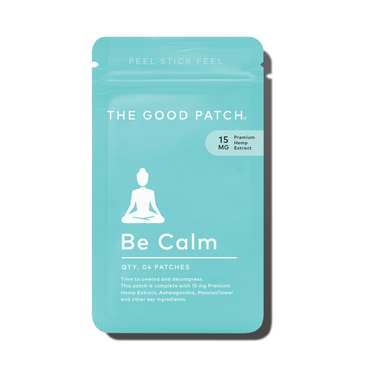Do you often hear the term “mindfulness” tossed around? Many of us have heard of this word, but it remains a mystery regarding what it is and how we can take advantage of it. Those aware of the practice may still struggle to find time to practice it with our packed schedules and the general hustle and bustle of daily life.
Besides, life in our busy world gets stressful, and constantly planning for the future or worrying about the past makes it difficult to enjoy the here and now. Even when you feel you have too many other responsibilities, you deserve to prioritize your mental health. If the stress of everyday life has been piling up, you’ve come to the right place for some encouragement and advice.
Here at The Good Patch, we know the impact stress can have on our minds and bodies. To help you fight it, we’ve collected some of our favorite strategies for introducing mindfulness into your life!
So, What Is Mindfulness?
The concept of mindfulness involves bringing your full attention to your thoughts, emotions, sensations, and environment in the present moment. This can manifest in many ways, and we each need to take the time to discover the practices that work best for us.
As you focus your attention, try to let go of judgment and be aware of your current state objectively. By turning our concentration wholly on the present, we tune out the noise of the past and future. Perhaps most importantly, there is no right or wrong way to practice mindfulness.
Learning to go into each day with mindfulness requires some effort. Still, even beginners can reap the benefits it brings to reduce stress and improve overall well-being, making the journey absolutely worth it. Read on to find out how to incorporate mindfulness into your daily life.
What Are the Benefits of Mindfulness?
Before we dive into strategy, here are a few of the benefits you can enjoy from practicing mindfulness:
- Stress Reduction
- Better Memory and Focus
- Emotional Balance
- Improved Mental Health
- Sleep and Restfulness
Now that you know the benefits, how do you start practicing mindfulness?
Follow a Routine
To turn mindfulness from an abstract idea into a daily practice, you’ll need to dedicate time and space to it. We’ll discuss in the following sections specific ways to be mindful — there are many! Before you can get started, it’s important to find a calm part of your day to do them.
Forming a routine is an important way to ensure you can be consistent with your new habit and create a schedule for your body to subconsciously prepare itself for your daily exercises.
If you struggle to find the time during the day, you may even consider practicing mindful walking on the way home from work or school — we’ll discuss this further later on. For many of us who have difficulty unwinding after a long day, our Ultimate Zen Duo is the perfect way to get in the right headspace for some mindfulness.
As we all know, plans aren’t written in stone, and things can change in the blink of an eye. Since mindfulness is all about acting with self-compassion, try not to be too hard on yourself if you miss a day or have to delay your routine.
Instead, take this as an opportunity to figure out why it didn’t work out and move on to your next responsibility. Applying mindfulness to your life will involve breaking habits like being overly self-critical.
Mindfulness and Meditation
This is likely the most famous method of mindfulness out there. What can be considered a condensed version of mindfulness, meditation also involves an elevated level of self-awareness.
This doesn’t mean you have to psychoanalyze every thought that enters your mind. Meditation practices usually ask you to simply take in your thoughts through pure observation.
We can all picture someone sitting crosslegged with an empty mind, but what often gets overlooked is that there are many types of meditation, such as:
- Spiritual
- Focused
- Movement
- Loving-Kindness
- Visualization
Regardless of the method you choose, gently bring it back to your current state as your mind wanders. A helpful analogy is to think of your thoughts as a toddler with a hard time sitting still. Each time your mind begins to stray, coax it back to the present with the love and tenderness you would with a child.
First-time meditators might struggle with staying focused for long periods, and that’s normal! Begin with three or six-minute meditation sessions and work your way up to more.
Mindfulness-Based Stress Reduction (MBSR)
Research shows that this program can help lessen mental and physical stress by building resilience and peace of mind through various mindfulness exercises. MBSR can act as a preventative and reactive strategy to stressors in your life.
To relax before a big day or to cope with any unexpected turbulence, you might want to try one of the following exercises:
- Breath-Focused Attention: It’s quite possible you already do this without knowing. As things start to feel overwhelming, stop for a moment and shift your awareness to deep breaths.
- Body Scan: Starting from the crown of your head, work your attention through your whole body. Stopping briefly at each body part, note where you feel good and where you might find discomfort.
- Walking Meditation: Along with other forms of movement meditation, switch it up by walking in circles or over longer distances.
- Mindful Eating: Instead of speeding through your meals, savor each bite and be aware of all the sensations that arise while you enjoy your delicious food.
Wrapping It Up
Remember, mindfulness is a practice that takes time and patience to develop. Don't worry if your mind wanders or you have difficulty staying focused. Simply acknowledge any distractions and gently redirect your attention back to your breath. With time and practice, mindfulness can help reduce stress and cultivate a sense of calm and well-being.
As always, if you need a little extra support, don’t hesitate to check out what we’ve got going at The Good Patch, like our Relax patch, to help you get started.
Sources:
MBSR: Mindfulness-Based Stress Reduction | Mindfulness Center | Brown University
9 Types of Meditation: Which One Is Right for You? | Healthline
Mindfulness Definition: What Is Mindfulness | University of California, Berkley







